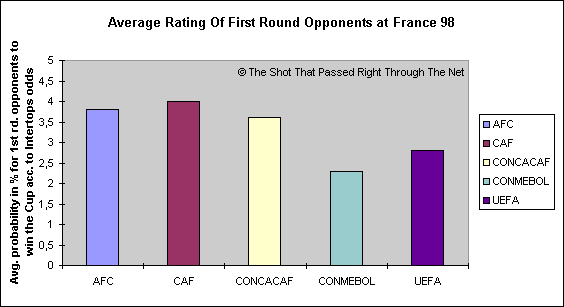| 3a) the relegation
zone after winning percentage
EuropeI/II=qual. as one of the
9 group-winners (I) or as one of the 5 runners-up (II)
Asia, Sth-America, and Nrth/Ctl-America=here
a ranking of the participants after the qualification performance is possible
(Asia only 3 and 4)
| 32 |
USA (Nth/Ctl-Am 2) |
0.000 |
| 31 |
Japan (Asia 3) |
0.000 |
| 30 |
South Korea (Asia 1-2) |
0.167 |
| 29 |
Bulgaria (Europe I) |
0.167 |
| 28 |
Saudi Arabia (Asia 1-2) |
0.167 |
| 27 |
Scotland (Europe II) |
0.167 |
| 26 |
Tunisa (Africa) |
0.167 |
and here the complete table:
(sorted on wpct, goal-difference)
team wpct
FRANCE 0,929
ITALY 0,800
NETHERLANDS 0,750
ARGENTINA 0,700
GERMANY 0,700
CROATIA 0,667
BRAZIL 0,643
ENGLAND 0,625
YUGOSLAVIA 0,625
ROMANIA 0,625
SPAIN 0,500
DANMARK 0,500
MEXICO 0,500
PARAGUAY 0,500
NORWAY 0,500
MOROCCO 0,500
BELGIUM 0,500
NIGERIA 0,500
CHILE 0,375
AUSTRIA 0,333
IRAN 0,333
COLOMBIA 0,333
CAMEROON 0,333
SOUTH AFRICA 0,333
JAMAICA 0,333
TUNISIA 0,167
SCOTLAND 0,167
SAUDI ARABIA 0,167
BULGARIA 0,167
SOUTH KOREA 0,167
JAPAN 0,000
USA 0,000
3b) the bottom 2 of each continent
accumulated
this table delivers a better image,
as 'drop-outs' (like Greece for Europe was in 1994 do not stand out as
much. Making a package out of the worst teams from each continent can show
who has really had too many weak teams (if you want to put it that negative):
below 0.500 are:
| Asia1 |
(Jap/Kor) |
0.083 |
| Europe1 |
(Bul/Sco) |
0.167 |
| Nth/Ctl-Am1 |
(USA/Jam) |
0.167 |
| Asia2 |
(KSA/Ira) |
0.250 |
| Africa1 |
(Tun/Cam) |
0.250 |
| South-Am1 |
(Col/Chi) |
0.357 |
| Africa2 |
(RSA/Nig) |
0.429 |
| Europe2 |
(Aus/Nor) |
0.429 |
3c) the bottom 3 of each continent
accumulated
alternative to 3b)
below 0.500 are:
| Asia1 |
(Jap/Kor/KSA) |
0.111 |
| Europe1 |
(Bul/Sco/Aus) |
0.222 |
| Africa1 |
(Tun/Cam/RSA) |
0.278 |
| Nth/Ctl-Am1 |
(USA/Jam/Mex) |
0.300 |
| South-Am1 |
(Col/Chi/Par) |
0.409 |
why statistics and
figures are not the exclusively important measure
You are interestet in more tables about former World
Cups? How Africa was put at disatvantage?
Check The
"true" World Cup tables 1982-1990 (all kinds of continents comparisons
and wpct-tables)
(1994 not yet available)
why statistics and
figures are not the exclusively important measure |
